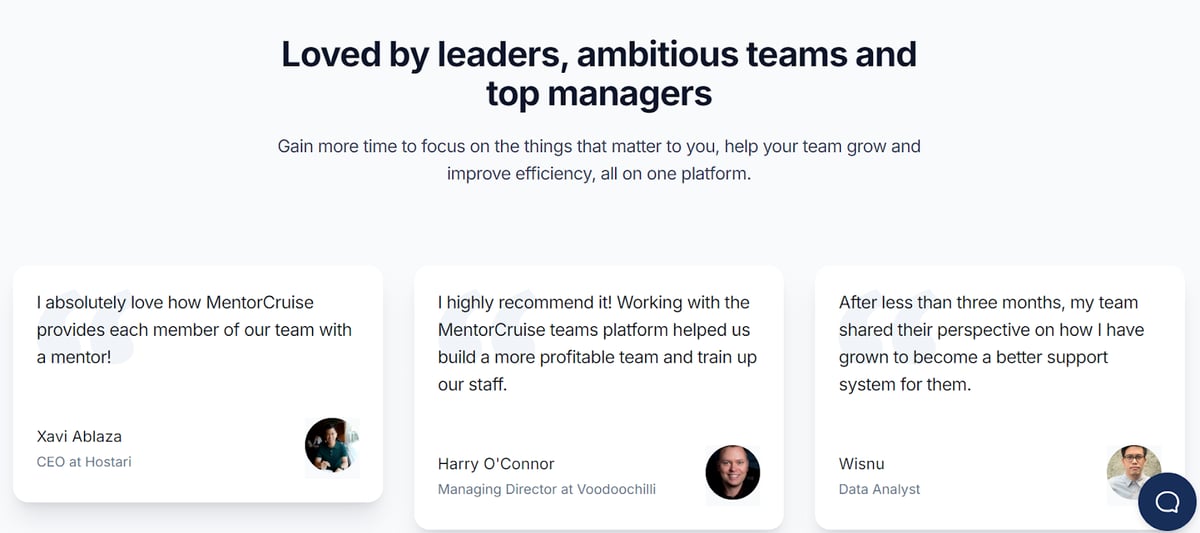Helpful summary
- Why You Can Trust Us: We’ve helped numerous organizations find mentors who guide them through complex changes, such as Mel Ross, who specializes in digital transformation and modern leadership.
- Why This Is Important: Effective organizational transformation boosts performance, solves cultural issues, enhances competitive advantage, and helps employees embrace change.
- Action Points: Implement a clear vision, holistic change management, stakeholder involvement, leadership alignment, employee-centric approaches, data-driven progress tracking, and fostering a high-performance culture.
- Further Research: Explore mentoring programs that can provide additional support during your transformation journey.
Need help with organizational transformation?
Whether you plan to pursue digital transformation or just a change in company culture, transforming your organization is the key to staying competitive in the market. Not only will you reach your business goals faster, but you’ll also be able to retain competent employees at a higher rate.
It’s time to turn organizational transformation from a dream into reality. In this MentorCruise guide, we’ll lay down seven simple steps to make this happen.
Why listen to us?
We have first-hand experience helping teams use mentoring to manage organizational transformation effectively. For example, one mentor of ours, Mel Ross specializes in digital transformation, modern leadership, and change management, providing guidance to leaders in navigating complex changes.

By leveraging the power of mentoring, our mentors create smooth transformations and better outcomes for both leaders and teams.
What is organizational transformation?
This refers to the process of aligning your organization’s culture, or how your employees work together, with its strategies on the trade-offs your company is willing to make to reach its goals.
Remember, these aren’t just minor adjustments. We’re talking about sparking radical change within your organization. You might adopt new technologies that transform your previous workflows. Or perhaps, you’ve decided on a bigger goal than ever before, and you need to onboard new employees to meet that target.
To sum it up, an organizational transformation is usually indicative of a significant change in your strategy.
Why is organizational transformation important?
Organizational transformation is crucial as it is tied to the outcomes of your business and thus, to its success.
It improves the company’s performance
A study showed that companies that implemented organizational transformation were more likely to meet their internal objectives than companies that did not. The elevated performance often comes from updated hierarchies and processes. This way, your team can live up to its potential.
It transforms the market it serves
When you transform your organization, you can also make a transformative impact on the market you serve. This includes setting the standards in terms of how your team embraces its social responsibility and molds its people to propel the company toward a better future.
It enhances company culture
Organizational transformation goes hand in hand with cultural transformation. As a result, you’re solving two or more problems at once; problems like high employee turnover, low engagement, and inconsistent work quality.
It can create a competitive advantage
When your company places organizational transformation at the top priority, you can focus on opening new departments or product lines, thus you create new competitive advantages. With this, your team will stand out in your industry.
It helps employees overcome their resistance to change
For your business to succeed, your employees must embrace change, rather than resist it, and this is possible with the right organizational transformation strategies.
7 steps to organizational transformation
Not sure where to start? Follow these steps to achieve the organizational transformation your business needs.
1. Define a clear vision, purpose, and goal
The first step is to make sure your organization has a clear vision, purpose, and goal. You must also communicate these to both your employees and leaders to lay the foundation for the transformation.
Here, start by clearly articulating the future state you aim to achieve with the transformation. Then, explain the underlying reason or rationale for the transformation. These are followed by setting SMART goals, developing a communication plan, and enlisting your organization for support.
Microsoft’s mission of empowering “every person and every organization on the planet to achieve more” is a good example of a clear goal.
2. Take a holistic approach to managing change
You need to see the picture from all angles. Organizations that make siloed decisions are usually ineffective. Make sure that you consult team leaders from all departments while carrying out your transformation.
Here are some steps you can take to do it:
- Assess the impact on organizational structure
- Evaluate technology needs
- Identify and address potential talent gaps
- Promote agility and collaboration
A classic example of a company that carried out this step well is General Electric, under the leadership of its former CEO, Jack Welch.
Welch ensured he managed change by restructuring and streamlining operations by selling off non-core businesses, instead steering GE to focus on its core competencies where it could be a market leader
He also implemented a cultural transformation, innovated digitally by investing in new technologies, developed leadership and talent, and adopted a customer-centric approach.
3. Prioritize key areas in your strategy
Changing everything at once never works. When you plan your strategy, it’s better to prioritize matters you want to tackle first and make sure that you’re capable of executing them.
Identify key areas for initial focus, and then gradually implement changes. Reprioritize as necessary when you see the need to change course.
When Satya Nadella became CEO of Microsoft in 2014, the company was facing significant challenges, including stagnation in its core Windows business and a lack of focus in its strategic direction. Nadella prioritized specific key areas to transform Microsoft into a more valuable, agile, cloud-focused, and innovative company.
4. Create a detailed timeline
To guarantee a smooth and successful transformation, you must also outline a firm timeline that describes exactly at which point each part of the strategy gets implemented.
To create a timeline, you must be able to define your end goals, then work backward through your departments. Make the timeline known throughout your organization with project management tools like ClickUp, and adjust as needed.
5. Involve your stakeholders – and communicate with them
Successful organizations take feedback from everyone. Involve your stakeholders, and involve them not just midway, but right from the start of the transformational process. Communicate with them on why your team is undergoing transformation, what their role is, and the benefits of this change.
Above all, you need to ask everyone, not just the higher-ups, for feedback. Many project managers might not have insight into the day-to-day tasks that are getting done, and what their pain points are. Discovering problems at that level is the key to getting everyone on the same page.
You also need to address disagreements proactively. A good example is when Lou Gerstner, the former CEO of IBM, addressed disagreements to steer the company towards a successful transformation when the company faced internal discord among its leadership under this tenure.
6. Use relevant data and metrics to measure progress
Measuring your team’s progress through relevant data and metrics will ensure your organizational transformation is on track and can achieve favorable results.
This was seen in Intel's implementation of the Objectives and Key Results (OKRs) framework during the leadership of former CEO Andy Grove. In the 1970s, Grove utilized OKRs to drive Intel's transformation and measure its progress.
Here are some metrics you can use:
- Employee engagement
- Customer satisfaction
- Financial performance
7. Create a high-performance culture to promote lasting change
This is about making sure every member of your team is committed to the transformation and is willing to do everything required to attain the desired results.
To create a high-performance culture that supports change, tick all the boxes on this checklist:
- Foster commitment at all levels
- Encourage alignment and engagement
- Empower teams to drive change
- Recognize and reward progress
- Motivate employees to improve
Best practices for transforming your organization
70% of organizational transformations fail. It takes a lot of conscious effort to do it right, follow these best practices for change management:
- Hire a Mentor: Transitioning your employees to new roles, as is often the case during your transformation, can be tough. Give your employees the chance to adapt with the help of a mentor from MentorCruise. They’ll be able to help employees cope with the challenges they face and discover new strategies to resolve them.
- Empower and Engage Employees: Actively involve employees in the transformation process by seeking their input and addressing their concerns. This can contribute to higher morale.
- Leverage Technology and Innovation: Embrace new technologies and innovative solutions to drive transformation. This can streamline processes, enhance efficiency, and provide new capabilities that support the organization’s goals.
- Maintain Transparent Communication: Ensure consistent and transparent communication throughout the transformation process. Keeping all stakeholders informed about progress, challenges, and changes builds trust and helps manage expectations.
- Foster a Culture of Flexibility and Adaptability: Encourage a culture that embraces change and is willing to adapt to new circumstances. This helps the organization remain resilient and responsive to unforeseen challenges and opportunities.
- Monitor and Celebrate Milestones: Regularly track progress against defined milestones and celebrate achievements along the way. Recognizing successes boosts morale and reinforces the commitment to the transformation efforts.
Conclusion
Managing organizational transformation means you need to get all hands on deck. Following through on the steps we listed here requires a lot of strategic planning and collaboration.
If you want to kick your organizational transformation off properly, consider seeking the expertise of a mentor.
Our platform lets your business access highly skilled and experienced mentors. We have mentors for both individuals and teams. Our mentors have already been through the wringer, so you know you’re getting expert insights.







